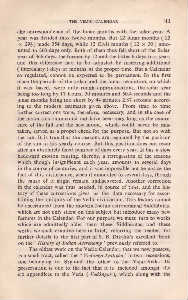Page 660 - Lokmanya Tilak Samagra (khand 2)
P. 660
THE VEDIC CALENDAR :13
the correspondence of the lunar months with the solar year. A
year was divided into twelve months. But 12 lunar months ( 12
X 29i) made 354 days, while 12 Civil months ( 12 X 30 ) amo-
unted to 360 days only. Both of them thus fell short of the Solar
year of 366 days, the former by 12 and the latter 6 days in a year;
and this difference had to be adjusted by inserting additional
( intercalary ) days or months at the proper time. But a Calendar
so regulated, cannot be expected to be permanent. In the first
place the periods of the solar and the lunar revolution, on which
it was based, were only rough approximations, the solar year
being too long by 17 hours, 50 minutes and 50.4 seconds and the
lunar months being too short by 44 minutes 2.87 seconds accord-
ing to the modern estimates given above. From time to time
further corrections were, therefore, necessary, and in the case of
the moon this time could not have been very long as the recurr-
ence of the full and the new moon, which could never be mis-
taken, served as a proper check for the purpose. But not so with
the sun. It is true that the seasons are regulated by the position
of the sun in his yearly course. But this position does not recur
mter an absolutely fixed number of days every year. It has a slow
backward motion causing, thereby, a retrogession of the seasons
which though insignificant each year, amounts to several days
in the course of centuries, and it was impossible not be notice the
fact of this disturbance, when it amounted to several days, though
the cause of it might remain undiscovered. Another correction
in the calendar was thus needed, in course of time, and the his-
tory of these corrections gives us the data necessary for ascer-
taining the antiquity of the Vedic civilization. This history cannot
be ascertained from the modern Indian astronomical Siddhantas,
which are not only silent on this subject but introduce many new
features in the Calendar. For our purpose we must turn to works
which are admittedly older than these Siddhantas, and these
works we shall examine here in brief, referring the reader, for
further details to the first part of S. B. Dik~hit's excellent book
on the ' History of Indian Astronomy ' previously referred to.
The oldest work on the Vedic Calendar, that we now possess,
is a small tract, called the ' Veddnga Jyoti~ha ' in two recensions,
one belonging to ~ig and the other to the Yajur-Veda. Its
preservation is due to the fact that it is included amongst the
six appendices to the Veda ( Vedangas ), which along with the

